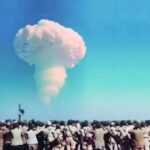Nuclear weapons cuts will make the United States safer
By Kingston Reif | March 6, 2013
Nuclear arms control is back in the news.
Nuclear arms control is back in the news. After paying little public attention to the issue over the long course of his reelection campaign, President Obama said in his February State of the Union address that the United States “will engage Russia to seek further reductions in our nuclear arsenals.” A recent report by the Center for Public Integrity revealed that senior Obama administration officials believe the United States can reduce its arsenal of deployed strategic warheads to between 1,000 and 1,100 without harming national security. Those numbers would put the total below levels called for by New START, the treaty that limits the United States and Russia to 1,550 deployed warheads apiece. Meanwhile, numerous high-ranking administration officials have met with their Russian counterparts this year. Further arms control measures were likely on the agenda.
Not surprisingly, many congressional Republicans have expressed opposition to further nuclear reductions. They argue that additional cuts would undermine US security and worry that the Obama administration could reduce the national arsenal outside the auspices of a formal treaty approved by the US Senate.
These concerns are misplaced: Further nuclear weapons reductions are squarely in the national interest.
First, as President Obama said in March 2012, “we have more nuclear weapons than we need.” Even after New START, he pointed out, the United States would have more than 1,500 deployed nuclear weapons and some 5,000 warheads. Such a large arsenal greatly exceeds any conceivable deterrence requirement and provides Russia with an incentive to maintain a similarly bloated force.
Bilateral reductions below the New START levels would reduce the number of Russian nuclear weapons pointed at the United States. Reductions could also strengthen stability by providing Russian defense planners with less reason to engage in costly worst-case estimates about force requirements. For example, lower US deployed force levels could dissuade Moscow from moving forward with destabilizing nuclear modernization programs — such as the development of a new heavy intercontinental ballistic missile (ICBM). Verifiable limits on reserve warheads and nonstrategic arms would further enhance stability by addressing Russia’s large stockpile of such weapons and ensuring that nuclear warheads are actually eliminated as opposed to merely placed in storage.
Maintaining a nuclear posture and force levels that are still largely based on Cold War-era conditions has many costs. As nuclear security and non-proliferation specialist James Doyle has written, “Given the generally positive nature of the US-Russian relationship, the continued competitive mutual nuclear entanglement hinders the development of truly normalised relations.” Keeping an excessive arsenal also costs money; $31 billion per year according to a 2012 study by the Stimson Center. The Pentagon and Energy Department are planning to spend hundreds of billions of dollars over the next decade to build new nuclear delivery systems and warhead-production facilities. Reductions would stem the need for a significant amount of this spending.
Some of those opposed to US nuclear weapons cuts argue that they are irresponsible in light of North Korea’s recent missile and nuclear tests and Iran’s continued enrichment of uranium. But reducing its number of deployed strategic warheads to 1,000 would leave the United States with far more than enough weapons to deter North Korea, which is believed to possess a total of about 10 nuclear weapons, and Iran, which doesn’t have any.
One of the most-repeated arguments against a new round of cuts involves the US nuclear umbrella: Some fear that reducing the American arsenal could cause allies to doubt the US commitment to their defense, thereby tempting them to acquire their own nuclear weapons. However, the continued US maintenance of thousands of nuclear weapons is not necessary to deter the nuclear threats our allies face today. Moreover, further arms control could actually benefit US partners: A US-Russia arms control process that addresses Russian nonstrategic nuclear weapons could reduce the threat posed by these weapons to America’s Central European and Baltic allies. Likewise, further reductions in the number of US and Russian nuclear weapons could pave the way for future Chinese participation in the arms control process, which in turn would reduce the Chinese nuclear threat to America’s East Asian allies.
Another criticism of further arms control contends that it is dangerous, because Russia likely will not come along unless the United States agrees to limitations on missile defense. It is true that Russia has not yet showed much interest in further nuclear weapons reductions, and that, at least publicly, it has linked further cuts to resolution of its concerns about US missile defenses and high-precision conventional strike capabilities.
But Moscow may still have good reasons to engage. As Brookings Institution arms control experts Steve Pifer and Michael O’Hanlon point out, “The US military can with its current force structure easily stay at the New START limits, while the Russian military must build new missiles to do so. Lowering the limits would offer Moscow a chance to save money. Also of interest to the Russians: Putting all weapons on the table would mean constraining reserve strategic warheads, where the U.S. military has a significant numerical advantage.”
In an ideal world, the United States and Russia would pursue a new round of nuclear reductions via a treaty that limits not only deployed strategic forces, but also non-deployed and nonstrategic nuclear warheads, which aren’t currently limited by any accord. However, the negotiation of such a treaty will be far more time-consuming and complex than the New START negotiations, which lasted about a year. In the meantime, Russia could deploy a new heavy ICBM, the momentum for further cuts could stall, and the two sides could make down payments on modernization plans that lock in excessively high force levels for decades to come.
To avoid these outcomes, the United States could jump start the process by declaring itself willing to reduce its deployed arsenal below the levels in New START if Moscow is willing to reciprocate. It’s a step that could save money, reduce Russia’s incentive to build a heavy ICBM, and pave the way for formal negotiations on a new treaty that limits all nuclear warheads. Non-treaty-based reductions have been a long-standing feature of US defense policy under both Republican and Democratic presidents.
As they pursue further weapons reductions, the United States and Russia should also pursue confidence-building and transparency measures that establish mutual trust and could be incorporated in future negotiations. Of particular importance are initiatives that address US concerns about Russia’s large stockpile of non-strategic weapons and Russia’s concerns about US missile defense and high-precision conventional weapons. Projects that might have that effect would include information sharing, joint experiments and studies, and enhanced dialogue.
The pursuit of further nuclear reductions will not be without significant challenges. Russia’s willingness to participate remains uncertain and Republican opposition is congealing. Nonetheless, President Obama should make the push he promised in the State of the Union. If he doesn’t, he’ll pass up a chance to significantly enhance US security.
Together, we make the world safer.
The Bulletin elevates expert voices above the noise. But as an independent nonprofit organization, our operations depend on the support of readers like you. Help us continue to deliver quality journalism that holds leaders accountable. Your support of our work at any level is important. In return, we promise our coverage will be understandable, influential, vigilant, solution-oriented, and fair-minded. Together we can make a difference.
Topics: Columnists, Nuclear Weapons















